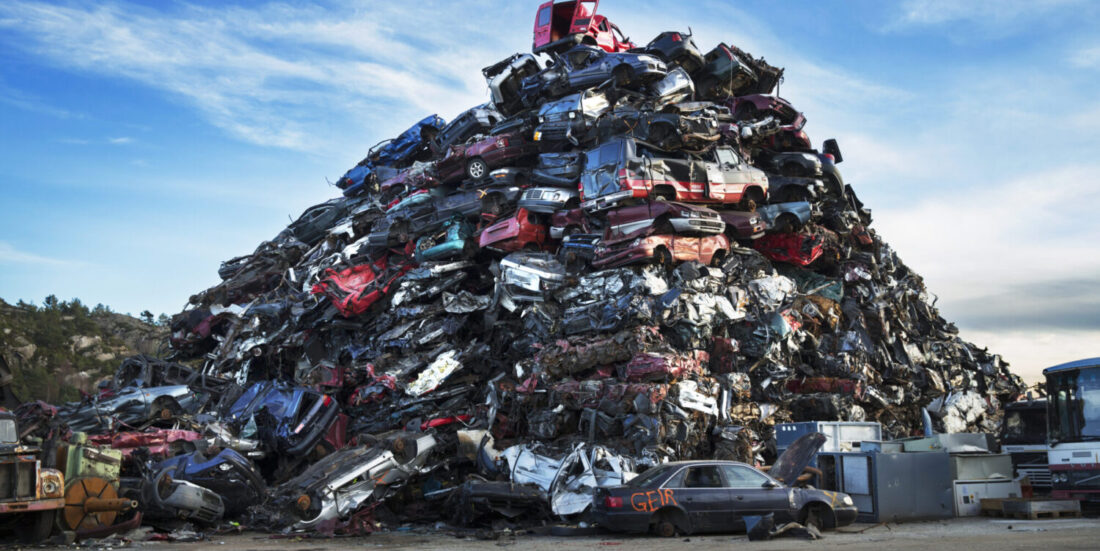The aluminium in your old car should be recycled into a new car, not something else
Unless we acquire greater knowledge about what happens at the atomic and molecular scale during materials recycling, progress towards a truly circular economy will grind to a halt.
Today, we’re all familiar with getting our deposits back on a mountain of bottles and cans. But this is only a very small step on the road to a circular economy.
We will not achieve this aim before all scrapped products can be converted into materials that can be reused time and time again. But, for this to take place, recycled materials must possess properties that are just as good as those they had when they were used in products for the first time.
Unless this happens, we will always be resorting to newly manufactured raw materials.
Challenging goals can be achieved
The recycling of all scrapped products is a demanding goal, but Norway is in a position to help meet the challenge. But for this to happen, the country has to follow through on what the government has been saying about materials in its national strategy for a green and circular economy.
Materials technology used to be a major area of research in Norway but has recently become less favoured when it comes to state funding. This is a pity because cost-sharing between the state and the industrial sector has traditionally promoted high levels of innovation – everything from light and robust vehicle steering rods, to systems that have led to significant reductions in CO2 emissions in the metallurgy sector.
If we fail to continue to invest in understanding our materials and why they behave as they do, it is not only innovation momentum that will be lost – our ambitions to achieve a circular economy will also fail.
Saving 95 per cent of the energy
Aluminium offers a good example in terms of what recycling can mean for a circular economy and the green transition.
The atoms in metals such as aluminium are stacked in orderly lattice structures, just like oranges in a supermarket. When a metal alloy is heated, the additive atoms start to move around, aided by the spaces created in the lattice.
When we melt aluminium from scrap to make new products, as companies such as Hydro and Speira are doing here in Norway, we consume only five per cent of the energy needed to smelt the same volume of new aluminium.
It is relatively easy to recycle the plastic in soft drinks bottles to make new bottles. Nor does it require any magic to turn the aluminium components in scrapped cars into new tea-light cups. But perhaps the time has come for the metal in these components to be recycled as aluminium parts in brand new cars?
We believe that this is the way to go if we want to avoid having to resort continually to producing large volumes of new aluminium. In doing so, we have to refuse to accept material quality losses during recycling. But such losses cannot be prevented without our intervention.
A lot we don’t fully understand
Car components are made of a variety of aluminium alloys. Additives are added to the aluminium in order to give it the properties required in the end product.
Steering rods have to remain strong as your car engine warms up around them. Fenders have to be robust, but also flexible enough to adequately absorb collisions.
So, if you melt all the aluminium from a car in a single ‘pot’, you will get a mixture, but the resulting metal will have none of the properties that the individual alloys possessed.
The Norwegian company Hydro is a world-leader in the recycling of aluminium. Nevertheless, there is a lot that even we in Norway do not fully understand about the optimum recycling of this metal.
A three-fold challenge
The challenge we face is three-fold. We have to be in a position where we can:
- effectively separate all aluminium components, and then remove any contaminants in the metal as efficiently as possible.
- identify those contaminants that we have not been able to remove and find out how we can prevent these from causing problems when the metal is recycled to make new products.
- exploit all available scrap for the manufacture of high quality alloys. This will require measures that achieve a balance between quality and any shortcomings caused by the additives remaining in the scrapped alloys.
Risk relief
This is where Norway can lead the way. The aluminium sector has a long tradition of utilising research results. If we build on this tradition, we will achieve our goals in the field of aluminium recycling.
However, the industry cannot be expected to do the job unaided. On the understanding that wide-ranging, basic research is never as straightforward as that addressing isolated problems, risk relief in the form of public sector funding is essential.
Atoms in lattices
An important part of materials technology is understanding how the internal structure of a material is impacted by manufacturing processes, and what this means for end product properties.
The atoms in metals such as aluminium are stacked in orderly lattice structures, just like oranges in a supermarket. When a metal alloy is heated, the additive atoms start to move around, aided by the spaces created in the lattice.
The strength and flexibility of an aluminium alloy will depend on the additives it contains and where in the lattice the additive atoms reside after processing. The extent and duration of heating will determine whether the additive atoms end up in sites within the lattice that confer the desired properties.
Batteries and plastics
Research has resulted in a number of aluminium alloys, each tailor-made using the additives and processes required to produce the optimal desired properties. This has been achieved by performing everything from curiosity-driven basic research to innovation and practical application in manufacturing companies.
However, in a circular economy, we have a different starting point. The additives that already exist in the raw scrap now become key to the process.
We must acquire new knowledge in order to be able efficiently to recycle all the components of scrapped cars as raw materials for new vehicle manufacture. This applies not only to aluminium, but also to other materials.
The world needs solutions that enable all kinds of materials, such as battery components, plastic products and metal components, to undergo repeated cycles of reuse.
But it doesn’t end here. The ultimate aim must be to enable recycled materials to possess even better properties than they had in their original applications.
This article was first published in the financial daily Dagens Næringsliv on 13 July 2023 and is reprinted here with the permission of the paper.



